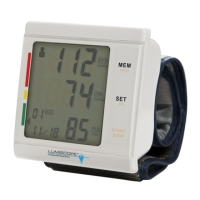26
About Blood Pressure
The incidence of hypertension increases with age. In addition, lack of exercise;
excess body fat; and high levels of cholesterol (LDL), which sticks to the inside
of blood vessels, reduce their elasticity. Hypertension accelerates
arterial sclerosis, which can lead to very serious conditions such as stroke and
myocardial infarction. For these reasons it is very important to know whether the
blood pressure is within a healthy range. Blood pressure fluctuates from minute
to minute throughout the day, making it essential to take regular measurements
to help you identify an average blood pressure.
27
About Blood Pressure
*Note!
When a person’s systolic and diastolic pressures fall into different categories, the
higher category should apply.
WHO
Red
Yellow
Green
80
85
90
100
110
Diastolic Blood Pressure (mmHg)
120 130 140 160 180
Systolic Blood Pressure (mmHg)
Optimal
blood pressure
(target value)
Normal blood pressure
Normal systolic value
Mild hypertension
Moderate hypertension
Severe hypertension
After each measurement is completed, the LCD will automatically show your
position on the six segments of the bar indicator which correspond to the WHO
(World Health Organization) Blood Pressure Indicator, shown below.
Reference Material: Journal of Hypertension 1999, Vol 17 No.2
Classification of Blood Pressure
High blood pressure can go unnoticed
for a long time, since it doesn’t cause
noticeable symptoms. The following
are all possible causes of abnormally
high blood pressure:
• Overweight;
• High cholesterol level;
• Smoking;
• Excessive alcohol consumption;
• Stress and emotional upset;
• Excessive consumption of salt;
• Lack of physical exercise;
• Genetic / hereditary predisposition;
• Underlying illness, such as kidney
disorders or endocrine disturbance.
If your blood pressure reaches upper
values of 140~160 mmHg and lower
values of 90~95 mmHg in repeated
measurements over several days, you
should consult your doctor for detailed
medical examination. You can assist
the treatment prescribed by your
doctor in the following ways:
• Lose weight and lower your
cholesterol level;
• Reduce the consumption of alcohol;
• Reduce the intake of salt;
• Stop smoking;
• Take regular exercise;
• Monitor your blood pressure.
28
About Blood Pressure
Classification of Blood Pressure
25
About Blood Pressure
Lower pressure
Relaxation of the
heart muscle
Pressure decreased
to the blood vessel
Blood returns to heart
Higher pressure
Contraction of
the heart muscle
Pressure increased
to the blood vessel
Extrude blood
Diastolic Blood PressureSystolic Blood Pressure
Blood Circulation
The blood circulation is responsible for supplying the body with oxygen.
Blood pressure is the pressure exerted on the arteries.
The systolic blood pressure value (higher pressure or top value) represents
the blood pressure produced by contraction of the heart muscle.
The diastolic blood pressure value (lower pressure or lower value) represents
the blood pressure produced by relaxation of the heart muscle.

